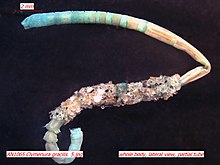Maldanidae
| Maldanidae | ||||||||||||
|---|---|---|---|---|---|---|---|---|---|---|---|---|

Rhodine bitorquata John Percy Moore, 1923 |
||||||||||||
| Systematics | ||||||||||||
|
||||||||||||
| Scientific name | ||||||||||||
| Maldanidae | ||||||||||||
| Malmgren , 1867 |
Maldanidae is the name of a species-rich family of Vielborstern (Polychaeta) in seas worldwide as detritus, particularly in tubes can be found in sand in the coastal zone and on the continental shelves.
features
The Maldanidae reach body lengths of 3 mm to more than 20 cm. The prostomium is fused with the peristomium and sometimes another, bristle-free segment to form a blunt head that does not have any antennae or palps, but has a pair of nuchal slits . In the subfamilies Euclymeninae and Maldaninae, there is a head hem and keel on the head and an anal plate at the rear end, which can be toothed or provided with cirrus .
All species of the Maldanidae have a fixed number of segments that they can replace in exact numbers if the front or rear end is lost. However, in the center of the body there are vital segments - typically the 8th, 9th, and 10th - the destruction of which leads to the death of the animal. The segments are very long, which makes the body reminiscent of bamboo stalks. The parapodia are reduced to low ribs running around the segment with a low, rounded notopodium on which various capillary- shaped bristles sit, and a long, toroidal neuropodium with hooks in one or two rows.
The animals have an evertable pharynx with a simple axially or ventrally located buccal organ and a throat membrane. The closed blood vessel system of the Maldanidae is well developed. In the genera Branchioasychis and Johnstonia , finger-shaped appendages that are strongly perfused with blood are located on the posterior segments, which are not considered to be homologous to the gills of other multi-bristles. The nephridia are designed as mixonephridia, which are located in the first segments.
habitat
The Maldanidae are common in seas from the polar regions to tropical reefs. They are common on the sedimentary bottoms of the continental shelves, but they also occur in seagrass meadows of shallow waters, on mud bottoms and algae mats in the intertidal zone. They live in soft sediments and often make up an important part of Bentic communities. Most species live below the intertidal zone and little is known about their biology.
Annular worms live in tubes that they build with the body's own mucus from mud, shill or sand, or in dug tunnels that they line with mucus. The tubes often protrude from the sediment.
Development cycle
Most species of the Maldanidae are sexually separated with external fertilization. There are numerous reproductive types in the family, but no plankton-eating larvae are known. There are free-swimming larvae nourished by yolk as well as direct development of the embryos into creeping worms. In several species of the Micromaldane genus, 2 to over 30 eggs are fertilized and incubated in the mother's tube. They develop into young worms that eventually crawl out of the mother's tube.
nutrition
The Maldanidae especially eat substrate , swallow large quantities of sand, digest the organic components and excrete the mineral components unchanged.
Genera
The more than 200 described species of the Maldanidae family are divided into the following subfamilies and over 30 genera :
- Bogueinae Hartman & Fauchald, 1971
-
Euclymeninae Arwidsson, 1906
- Abyssoclymene Hartman, 1967
- Aclymene Buzhinskaya, 1995
- Axiothella Verrill, 1900
- Caesicirrus Arwidsson, 1911
- Clymenella Verrill, 1873
- Clymenura Verrill, 1900
- Euclymene Verrill, 1900
- Eupraxillella Hartmann-Schröder & Rosenfeldt, 1989
- Heteroclymene Arwidsson, 1906
- Leiochone Pit, 1868
-
Lumbriclymeninae Arwidsson, 1906
- Clymenopsis Verrill, 1900
- Lumbriclymene Sars, 1872
- Lumbriclymenella Arwidsson, 1911
- Nicomachella Ehlers, 1887
- Praxillura Verrill, 1879
-
Maldaninae Arwidsson, 1906
- Asychis Kinberg, 1867
- Bathyasychis Detinova, 1982
- Chirimia Light, 1991
- Heteromaldane Ehlers, 1908
- Maldane Pit, 1860
- Maldanopsis
- Metasychis Light, 1991
- Sabaco Kinberg, 1867
-
Nicomachinae Arwidsson, 1906
- Nicomache Malmgren, 1865
- Petaloproctus Quatrefages, 1866
-
Notoproctinae
- Notoproctus Arwidsson, 1906
-
Rhodininae Arwidsson, 1906
- Rhodine Malmgren, 1865
- without subfamily
- Gravierella Fauvel, 1919
- Iphianissa Kinberg, 1866
- Isocirrus Arwidsson, 1906
- Johnstonia
- Mandrocles Kinberg, 1866
- Micromaldane Monro, 1939
- Minusculisquama Pettibone, 1983
- Mylitta Kinberg, 1866
- Neco Kinberg, 1866
- Petaloclymene
- Proclymene Arwidsson, 1906
- Sonatsa Chamberlin, 1919
literature
- Stanley J. Edmonds: Fauna of Australia, Volume 4A. Polychaetes & Allies. The Southern Synthesis 4. Commonwealth of Australia, 2000. Class Polychaeta. Pp. 96-99, Family Maldanidae.
Web links
- G. Read (2004): About Family Maldanidae polychaetes in New Zealand.
Individual evidence
- ↑ Maldanidae Malmgren, 1867. WoRMS , 2018. Retrieved November 19, 2018.



